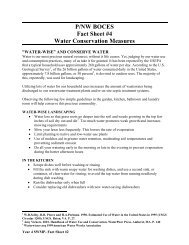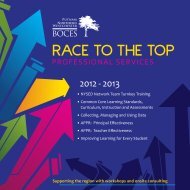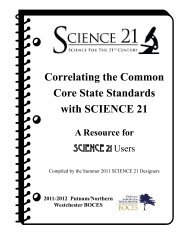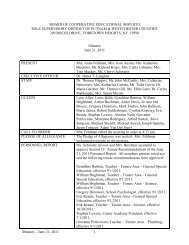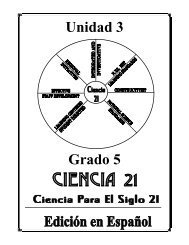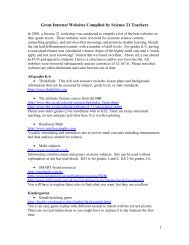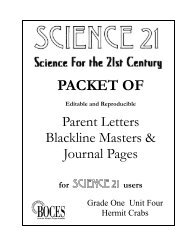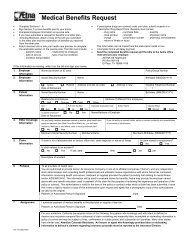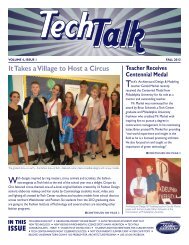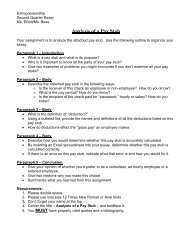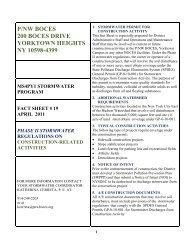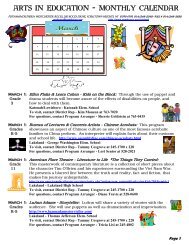Create successful ePaper yourself
Turn your PDF publications into a flip-book with our unique Google optimized e-Paper software.
PACKET OF<br />
Editable and Reproducible<br />
Parent Letters<br />
Blackline Masters &<br />
Journal Pages<br />
for SCIENCE 21 users<br />
Grade Two Unit Three<br />
<strong>Triops</strong>
Dear SCIENCE 21 User,<br />
Several teachers have asked for a separate packet of<br />
editable and reproducible documents that includes the<br />
Parent Letters, Blackline Masters, and Journal Pages that<br />
are a part of the SCIENCE 21 program.<br />
<strong>The</strong> documents on this media are provided in MS<br />
Publisher Format and may be used by SCIENCE 21<br />
participants to print, adapt, and customize any of these<br />
important components. For example, teachers often like<br />
to reproduce the parent letters onto their school<br />
stationery, or adapt worksheets for tiered activities or to<br />
meet small group needs.<br />
We hope that this new service will be useful to you and we<br />
appreciate your support and comments.<br />
Sincerely,<br />
Abby B. Bergman<br />
SCIENCE 21 Coordinator
SCIENCE 21
Dear Family,<br />
Date____________________<br />
This next science unit is on life science. Your child will be studying plants<br />
and a live animal. This unit is inquiry-based. Skills that are emphasized<br />
include observing, classifying, measuring, collecting and interpreting data.<br />
In this unit, the students will first observe the basic parts of a plant and an<br />
animal called <strong>Triops</strong>. <strong>The</strong>n they will compare them to other plants and<br />
animals.<br />
Students will develop a positive attitude towards this animal by learning how<br />
to care for it, determining it’s needs for survival, and setting up a habitat.<br />
We look forward to some exciting experiences in school and hope you will<br />
encourage your child to share them with you at home.<br />
Thank you for your support.<br />
Sincerely,<br />
7
Dear Family,<br />
In the Science 21 program, your child is studying a live animal called the<br />
<strong>Triops</strong>. <strong>Triops</strong> are small crustaceans that look like miniature horseshoe<br />
crabs.<br />
In this unit, the students will observe the basic parts of the <strong>Triops</strong> and<br />
compare it to other animals. As they care for the <strong>Triops</strong>, they will note<br />
their behavior and responses to various stimuli. Students will develop a<br />
positive attitude towards this organism by learning how to care for it,<br />
determining it’s needs for survival and by setting up a habitat.<br />
We look forward to some exciting experiences in school and hope you<br />
will encourage your child to share them with you at home.<br />
Sincerely,<br />
69
Garlic<br />
Sunflower<br />
Grade 2, Unit 3, Lesson 1, Blackline Master #1<br />
“Great Mountain”<br />
Garlic<br />
Radish<br />
31
Grade 2, Unit 3, Lesson 1, Blackline Master #2<br />
Sunflower<br />
33
Grade 2, Unit 3, Lesson 1, Example of Student Work<br />
35
Name_______________________________<br />
Rubric<br />
Grade 2, Unit 3, Lesson 2, Blackline Master<br />
Accomplished Proficient Developing Beginning<br />
Topic 4 3 2 1<br />
Notes and<br />
observations<br />
Complete and<br />
detailed<br />
observations.<br />
Measurement 6+ accurate<br />
measurements.<br />
Drawing Clear, tidy,<br />
complete.<br />
Involvement<br />
in overall<br />
plant unit<br />
Enthusiastic;<br />
contributes;<br />
respects<br />
equipment.<br />
Complete<br />
observations;<br />
a few details<br />
missing.<br />
5-6 accurate<br />
measurements.<br />
Careless,<br />
complete.<br />
Shows<br />
interest;<br />
contributes<br />
some ideas;<br />
somewhat<br />
careful.<br />
Partial<br />
observations<br />
on the seed<br />
or bulb.<br />
3-4 accurate<br />
measurements.<br />
Not accurate<br />
and<br />
incomplete.<br />
Shows some<br />
interest, but<br />
doesn’t<br />
contribute;<br />
sometimes<br />
careless<br />
with<br />
equipment.<br />
Incomplete;<br />
needs more<br />
observations.<br />
1-2 accurate<br />
measurements.<br />
Inaccurate,<br />
careless,<br />
incomplete.<br />
Lacks<br />
interest;<br />
doesn’t<br />
contribute;<br />
doesn’t<br />
respect<br />
equipment.<br />
Total_______________________<br />
47
NOA Onion Trivia Page 1 of 1<br />
http://www.onions-usa.org/folders.gif.map?85,116<br />
ONION TRIVIA<br />
One of the world’s oldest cultivated vegetables, this member of the lily family<br />
was considered sacred by ancient Egyptians, as valuable as gold in the Middle<br />
Ages and a vital food for many historical military commanders on land and sea.<br />
<strong>The</strong> onion has long been known as a symbol of eternity. Ancient Egyptian took<br />
an oath of office with their right hand on an onion believing it to be a symbol of<br />
eternity since the layers formed a sphere within a sphere. Byzantine<br />
architecture uses the symbolic onion shape as a dome for many of their<br />
religious structures.<br />
During the Middle Ages, onions were so valuable, they were used as rent<br />
payments and wedding gifts.<br />
Christopher Columbus brought onions to the New World from Europe.<br />
Flavorful and nutritious, they were a welcome addition to the first Thanksgiving<br />
feast.<br />
Captain James Cook applied the onion remedy in the eighteenth century for<br />
scurvy on his voyages to remote areas of the Pacific. At one point, Cook<br />
refused to sail until each man in his crew ate 20 pounds of onions followed by<br />
10 pounds two days later.<br />
During the Civil War, General Ulysses S. Grant sent an urgent message to the<br />
War Department saying, “I will not move my army without onions.” <strong>The</strong> next<br />
day, three trainloads were on their way to the front.<br />
FOOD SERVICE<br />
MENU<br />
EDITOR’S<br />
CUPBOARD<br />
HOME<br />
MEMBERSHIP<br />
INFORMATION<br />
GROWING<br />
AREAS<br />
ALLIED<br />
INDUSTRY<br />
49
<strong>Triops</strong><br />
Grade 2, Unit 3, Lesson 3, Blackline Master #1<br />
65
Where Can We Find <strong>Triops</strong>?<br />
Grade 2, Unit 3, Lesson 3, Blackline Master #2<br />
67
<strong>Triops</strong> Dot Strip<br />
Cut dot strips and give one to each student.<br />
Grade 2, Unit 3, Lesson 4, Blackline Master #1<br />
77
Trilobite<br />
Grade 2, Unit 3, Lesson 4, Blackline Master #2<br />
79
Trilobite<br />
Grade 2, Unit 3, Lesson 4, Blackline Master #3<br />
81
Trilobite<br />
Grade 2, Unit 3, Lesson 4, Blackline Master #4<br />
83
Trilobite<br />
Grade 2, Unit 3, Lesson 4, Blackline Master #5<br />
85
Trilobite<br />
Grade 2, Unit 3, Lesson 4, Blackline Master #6<br />
87
<strong>Triops</strong><br />
Grade 2, Unit 3, Lesson 5, Blackline Master #1<br />
93
<strong>Triops</strong><br />
Grade 2, Unit 3, Lesson 5, Blackline Master #2<br />
95
first appendage<br />
food groove<br />
tail<br />
<strong>The</strong> <strong>Triops</strong> ~ Underside<br />
Grade 2, Unit 3, Lesson 6, Blackline Master #1<br />
mouth<br />
trunk appendages<br />
egg pouch<br />
101
<strong>The</strong> <strong>Triops</strong> ~ Upperside<br />
Grade 2, Unit 3, Lesson 6, Blackline Master #2<br />
eyes<br />
first appendage<br />
carapace<br />
tail<br />
103
1. How do <strong>Triops</strong> swim?<br />
Questions About <strong>Triops</strong><br />
Grade 2, Unit 3, Lesson 6, Blackline Master #3<br />
When a <strong>Triops</strong> turns upside down, you can see how they swim. <strong>Triops</strong> use their trunk appendages.<br />
If you look closely, you can see them beat in waves. <strong>The</strong> wave starts at the rear of the animal and<br />
moves to the front.<br />
2. What parts of the body do they use to move forward?<br />
<strong>The</strong> trunk appendages help the <strong>Triops</strong> move forward when they are free swimming in the water.<br />
When they are at the bottom, the trunk appendages “walk” along the gravel, just like when you<br />
walk along the bottom of a swimming pool.<br />
3. What other movements and behaviors can you see?<br />
<strong>Triops</strong> spin and swim upside down. <strong>The</strong>y twist their tails and move in circles. <strong>The</strong> carapace isn’t<br />
flexible, but the rest of the body is. So, they can move in lots of different ways. <strong>The</strong>y also like to<br />
dig in sand and gravel. <strong>The</strong>y bulldoze their way through a pile of sand, pushing with their carapace<br />
against the grains. <strong>The</strong>y move forward using the push of the trunk appendages.<br />
4. What parts of the body are used to find food? What does a <strong>Triops</strong> do when it finds food?<br />
When a <strong>Triops</strong> swims past a lump of <strong>Triops</strong> food, it often turns towards it. It can probably detect<br />
chemicals from the food in the water (possibly with its first appendages). <strong>The</strong>n, it tends to turn<br />
onto its back and grab the food with its trunk appendages. <strong>The</strong>y move the food forward towards the<br />
mouth. <strong>The</strong> front trunk appendages have bristles on them (you can’t really see these even with a<br />
hand lens) which sieve food from the sand, gravel and water.<br />
5. What parts of the body are used to eat food?<br />
When the food reaches the mouth, you can see the mouth parts (mandibles) moving and chewing<br />
the food.<br />
6. What other body parts have you noticed?<br />
<strong>The</strong> long, first appendages (that look like antennae), touch and feel the sand in front of the <strong>Triops</strong>.<br />
<strong>The</strong> tail is long and flexible. It moves around a lot. Maybe it helps the <strong>Triops</strong> to steer when<br />
swimming, like a rudder. It has 2, long points at the end.<br />
<strong>The</strong> carapace is like a shell, covering the front half of the <strong>Triops</strong>. It looks like a shield, and<br />
probably offers some body protection. It also helps push through sand when searching for food.<br />
<strong>The</strong> carapace is quite colorful when the <strong>Triops</strong> get older, and can be bluish, green, brown, or<br />
reddish.<br />
<strong>Triops</strong> have 2 eyes. You can see them quite clearly as dark, kidney-bean shaped areas at the front<br />
of the carapace. Between the eyes, there is a dorsal organ which can be seen with a hand lens. In<br />
some species this looks like a third eye, hence the name <strong>Triops</strong> (three eyes). In mature <strong>Triops</strong>, you<br />
may see the egg pouch. This looks like a small, white bag underneath either side of the body (like a<br />
golf ball). <strong>The</strong> egg pouches are found where the carapace ends. You may see eggs if you look with<br />
a hand lens. <strong>The</strong>y are tiny, whitish - yellow dots in the pouch.<br />
105
Map of the World in the Triassic<br />
Grade 2, Unit 3, Lesson 8, Blackline Master #1<br />
119
Horsetail<br />
Cyad<br />
Norfolk Island Pine<br />
Grade 2, Unit 3, Lesson 8, Blackline Master #2<br />
Ginkgo<br />
Glossopteris<br />
121
Plateosaurus<br />
Riojasaurus<br />
Grade 2, Unit 3, Lesson 8, Blackline Master #3<br />
123
Coelophysis<br />
Grade 2, Unit 3, Lesson 8, Blackline Master #4<br />
Lesothosaurus Eoraptor<br />
Saltopus<br />
125
Procompsognathus<br />
Euparkeria<br />
Teratosauras<br />
Grade 2, Unit 3, Lesson 8, Blackline Master #5<br />
<strong>The</strong>codontosaurus<br />
127
Postosuchus<br />
Desmatosuchus<br />
Grade 2, Unit 3, Lesson 8, Blackline Master #6<br />
129
Grade 2, Unit 3, Lesson 8, Blackline Master #7<br />
Gerrothorax Proganochelys<br />
Cynognathus<br />
Sauropterygian<br />
131
Grade 2, Unit 3, Lesson 8, Blackline Master #8<br />
Thrinaxodon Lystrosaurus<br />
Morganucodon<br />
Eudimorphodon<br />
133
Sea Urchin<br />
Bivalves<br />
Gastropod<br />
Port Jackson Shark<br />
Ichythosaur<br />
Grade 2, Unit 3, Lesson 8, Blackline Master #9<br />
Ammonite<br />
135
(Name of Student)<br />
Has Successfully Discovered New and Interesting Facts About<br />
at<br />
(Name of School)<br />
(Date)<br />
(Signature of Teacher)<br />
143
Name_________________________________ Date_____________________<br />
Write vocabulary words that begin with the letters in our animal’s name.<br />
Grade 2, Unit 3, Lesson 9, Blackline Master #2<br />
145
molt<br />
<strong>The</strong> Life Cycle of <strong>Triops</strong><br />
molt<br />
adult<br />
Please note:<br />
• <strong>The</strong>se drawings are not the real sizes of the <strong>Triops</strong>.<br />
Grade 2, Unit 3, Lesson 10, Blackline Master #1<br />
egg<br />
molt<br />
larva<br />
young<br />
<strong>Triops</strong><br />
• How many molts the <strong>Triops</strong> goes through depends on how much food<br />
it eats.<br />
• <strong>The</strong> life cycle may stop at the egg stage if the pond is dried up. It<br />
starts again when it rains.<br />
153
<strong>The</strong> Stages of Human Growth<br />
Infancy:<br />
• Babies grow rapidly in their first year.<br />
• <strong>The</strong>y grow 1” per month for 6 months.<br />
• Body weight doubles in 5 months.<br />
• <strong>The</strong>y learn to walk, and eat solid foods.<br />
Grade 2, Unit 3, Lesson 10, Blackline Master #2<br />
Early childhood/toddler:<br />
• Slower growth.<br />
• Development continues, (e.g., learn to run and handle toys.)<br />
Pre-school/elementary:<br />
• Physical growth and muscle growth continues.<br />
• Mental growth at school.<br />
Adolescence:<br />
• Rapid physical growth.<br />
Adult:<br />
• Adults stop growing physically.<br />
• Humans age in appearance.<br />
Adult<br />
Adolescence<br />
Infancy<br />
Early childhood<br />
Pre-school<br />
155
Grade 2, Unit 3, Lesson 10, Blackline Master #3<br />
Data Table of Animal Life Spans<br />
Animal<br />
Questions:<br />
1. Which animal in this table has the longest life span?<br />
2. Two animals have average life spans of 10 years. What are they?<br />
3. What is the average life span of a giraffe?<br />
Average Life Span<br />
Hedgehog 10 years<br />
Giraffe 20 years<br />
Killer whale 90 years<br />
Giant tortoise 150 years<br />
Dog 10 years<br />
Hamster 2 years<br />
Newt 3 years<br />
Snail 3 years<br />
Elephant 80 years<br />
4. How many animals in this table have a life span of less than 15 years?<br />
5. Arrange the animals in order from shortest to longest lived.<br />
6. Make a graph to show the life span of these animals.<br />
157
NO MORE TICKS ON ME Grade 2, Unit 3, Lesson 11, Blackline Master #1<br />
Name___________________________ Date_______________<br />
Circle the correct answer:<br />
Lyme Disease Quiz<br />
1. How do ticks get on people?<br />
a. <strong>The</strong>y fly<br />
b. <strong>The</strong>y jump<br />
c. <strong>The</strong>y attach onto them<br />
2. What can ticks give you?<br />
a. Chicken pox<br />
b. Measles<br />
c. Lyme disease<br />
3. Where do ticks live?<br />
a. On fallen leaves<br />
b. On plants<br />
c. On grass<br />
d. All of these<br />
4. Lyme disease may be prevented by:<br />
a. Tucking your pant legs into your<br />
socks<br />
b. Wearing shorts<br />
c. Making your own trail in the woods<br />
5. If you have Lyme disease, you may see a red<br />
rash on your skin.<br />
a. Yes<br />
b. No<br />
6. What does a tick look like?<br />
a. A small spider<br />
b. A butterfly<br />
c. An ant<br />
*Modified from NYS Department of Health, Lyme School Packet.<br />
167
Grade 2, Unit 3, Lesson 11, Blackline Master #2<br />
YOUR SOCKS!<br />
169
Grade 2, Unit 3, Lesson 11, Blackline Master #3<br />
Name_______________________________________________<br />
Can you find and circle all 10<br />
ticks in these woods?<br />
171
Name___________________________________<br />
Grade 2, Unit 3, Lesson 11, Blackline Master #4<br />
173
Name________________________________<br />
Grade 2, Unit 3, Lesson 11, Blackline Master #5<br />
175
Name_____________________________Date_____________________<br />
Here is a drawing of my ____________________bulb.<br />
How are seeds and bulbs alike and different?<br />
1.<br />
2.<br />
3.<br />
Alike<br />
1.<br />
2.<br />
3.<br />
Different<br />
Grade 2, Unit 3, Lesson1<br />
1
Name___________________________Date____________________<br />
Observing seeds and bulbs<br />
This is a drawing of___________________<br />
This is a drawing of____________________<br />
Grade 2, Unit 3, Lesson 1<br />
2
Name_____________________________Date_____________________<br />
Science Observation<br />
I looked at___________________________________.<br />
This is what I observed:<br />
I noticed<br />
Grade 2, Unit 3, Lesson1<br />
__________________________________________________________________<br />
__________________________________________________________________<br />
__________________________________________________________________<br />
__________________________________________________________________<br />
__________________________________________________________________<br />
3
My Plant Journal<br />
Grade 2, Unit 3, Lesson 2<br />
By.........................................<br />
4
Name______________________________<br />
How My Bulb Grows<br />
Grade 2, Unit 3,Lesson 2<br />
date................. date................. date................. date.................<br />
10 cm<br />
10 cm<br />
10 cm<br />
10 cm<br />
Leaves<br />
Roots<br />
9 cm<br />
8 cm<br />
7 cm<br />
6 cm<br />
5 cm<br />
4 cm<br />
3 cm<br />
2 cm<br />
1 cm<br />
0 cm<br />
1 cm<br />
2 cm<br />
3 cm<br />
4 cm<br />
5 cm<br />
6 cm<br />
7 cm<br />
8 cm<br />
9 cm<br />
10cm<br />
Leaves<br />
Roots<br />
9 cm<br />
8 cm<br />
7 cm<br />
6 cm<br />
5 cm<br />
4 cm<br />
3 cm<br />
2 cm<br />
1 cm<br />
0 cm<br />
1 cm<br />
2 cm<br />
3 cm<br />
4 cm<br />
5 cm<br />
6 cm<br />
7 cm<br />
8 cm<br />
9 cm<br />
10cm<br />
Leaves<br />
Roots<br />
9 cm<br />
8 cm<br />
7 cm<br />
6 cm<br />
5 cm<br />
4 cm<br />
3 cm<br />
2 cm<br />
1 cm<br />
0 cm<br />
1 cm<br />
2 cm<br />
3 cm<br />
4 cm<br />
5 cm<br />
6 cm<br />
7 cm<br />
8 cm<br />
9 cm<br />
10cm<br />
Leaves<br />
Roots<br />
9 cm<br />
8 cm<br />
7 cm<br />
6 cm<br />
5 cm<br />
4 cm<br />
3 cm<br />
2 cm<br />
1 cm<br />
0 cm<br />
1 cm<br />
2 cm<br />
3 cm<br />
4 cm<br />
5 cm<br />
6 cm<br />
7 cm<br />
8 cm<br />
9 cm<br />
10cm<br />
5
(Measurement Extensions, if needed)<br />
Leaves<br />
Roots<br />
date............... date...............<br />
20 cm<br />
19 cm<br />
18 cm<br />
17 cm<br />
16 cm<br />
15 cm<br />
14 cm<br />
13 cm<br />
12 cm<br />
11 cm<br />
11 cm<br />
12 cm<br />
13 cm<br />
14 cm<br />
15 cm<br />
16 cm<br />
17 cm<br />
18 cm<br />
19 cm<br />
20 cm<br />
Leaves<br />
Roots<br />
30 cm<br />
29 cm<br />
28 cm<br />
27 cm<br />
26 cm<br />
25 cm<br />
24 cm<br />
23 cm<br />
22 cm<br />
21 cm<br />
21 cm<br />
22 cm<br />
23 cm<br />
24 cm<br />
25 cm<br />
26 cm<br />
27 cm<br />
28 cm<br />
29 cm<br />
30 cm<br />
Grade 2, Unit 3, Lesson 2<br />
6
Name______________________________________<br />
Class Radish Measurements<br />
• Make observations, once a week for 4 weeks. Date planted__________________<br />
• Radishes will have to be removed from the soil to make<br />
the measurements. Date sprouted_________________<br />
Date Height of plant (cm) Length of radish plant<br />
root and leaves (cm)<br />
Date...............<br />
Date...............<br />
Date...............<br />
Grade 2, Unit 3, Lesson 2<br />
Date...............<br />
7
Name______________________________________<br />
How My Sunflower Seed Grows<br />
Observe and record: 1) Height of the plant 2) Size, number, color and shape of leaves<br />
3) Changes in the plant stem 4) Number and color of flowers 5) Drawing of the plant.<br />
Date and time Notes Drawing<br />
Height.....................cm .......................inches<br />
Date.......................<br />
Leaves ................................................................................<br />
Time......................<br />
Stem ...................................................................................<br />
.............................................................................................<br />
Height.....................cm ........................inches<br />
Date.......................<br />
Leaves ................................................................................<br />
Time......................<br />
Stem ...................................................................................<br />
.............................................................................................<br />
.............................................................................................<br />
Grade 2, Unit 3, Lesson 2<br />
.............................................................................................<br />
.............................................................................................<br />
8
Name______________________________<br />
How my ...............................................seed grows.<br />
Draw a picture of how your seed looks.<br />
date...........<br />
date...........<br />
date...........<br />
date...........<br />
Grade 2, Unit 3, Lesson 2<br />
9
Name___________________________Date____________________<br />
How My Sunflower Seed Grows<br />
Label drawings. Write what is happening in each picture. (1-2 sentences).<br />
_______________________________ _______________________________<br />
_______________________________ _______________________________<br />
_______________________________ _______________________________<br />
_________________________________ ________________________________<br />
_________________________________ ________________________________<br />
_________________________________ ________________________________<br />
Grade 2, Unit 3, Lesson 2<br />
10
Name___________________________<br />
Class Cup Results<br />
Type of Condition What Happened<br />
....................................................<br />
....................................................<br />
....................................................<br />
....................................................<br />
....................................................<br />
....................................................<br />
....................................................<br />
....................................................<br />
....................................................<br />
....................................................<br />
....................................................<br />
....................................................<br />
Grade 2, Unit 3, Lesson 2<br />
.........................................................................<br />
.........................................................................<br />
.........................................................................<br />
.........................................................................<br />
.........................................................................<br />
.........................................................................<br />
.........................................................................<br />
.........................................................................<br />
.........................................................................<br />
.........................................................................<br />
.........................................................................<br />
.........................................................................<br />
11
Grace 2, Unit 3, Lesson 3<br />
Name___________________________ Date_____________________<br />
Today is day _______________<br />
This is what I observed:<br />
Draw<br />
<strong>Triops</strong> Journal Page<br />
Notes:____________________________________________________________<br />
__________________________________________________________________<br />
__________________________________________________________________<br />
We noticed: _______________________________________________________<br />
__________________________________________________________________<br />
__________________________________________________________________<br />
__________________________________________________________________<br />
12
Name of scientists:<br />
1.<br />
2.<br />
3.<br />
4.<br />
5.<br />
6.<br />
7.<br />
8.<br />
9.<br />
10.<br />
Measuring <strong>The</strong> <strong>Triops</strong><br />
Make sure you write down the units of measurement that you used.<br />
Grade 2, Unit 3, Lesson 4<br />
Day/date Estimate/measurement of size<br />
in________________________<br />
13
Grade 2, Unit 3, Lesson 5<br />
Name__________________________ Date______________________<br />
Draw the animal<br />
<strong>Triops</strong><br />
14
Grade 2, Unit 3, Lesson 5<br />
Name__________________________ Date______________________<br />
Observations of <strong>Triops</strong><br />
Select at least 3 questions to write about in your paragraph.<br />
I am going to include:<br />
1. __________________________________________________________________________<br />
2. __________________________________________________________________________<br />
3. __________________________________________________________________________<br />
______________________________<br />
____________________________________________________________________________<br />
____________________________________________________________________________<br />
____________________________________________________________________________<br />
____________________________________________________________________________<br />
____________________________________________________________________________<br />
____________________________________________________________________________<br />
____________________________________________________________________________<br />
____________________________________________________________________________<br />
____________________________________________________________________________<br />
____________________________________________________________________________<br />
____________________________________________________________________________<br />
____________________________________________________________________________<br />
____________________________________________________________________________<br />
15
Dear_________________________________,<br />
Grade 2, Unit 3, Lesson 5<br />
Date____________________________<br />
Guess what animal we have in our classroom? It is called a <strong>Triops</strong>. I’ve<br />
never seen anything quite like it before.<br />
This is what it looks like_____________________________________________________<br />
____________________________________________________________________________<br />
____________________________________________________________________________<br />
____________________________________________________________________________<br />
____________________________________________________________________________<br />
____________________________________________________________________________<br />
____________________________________________________________________________<br />
____________________________________________________________________________<br />
____________________________________________________________________________<br />
____________________________________________________________________________<br />
____________________________________________________________________________<br />
____________________________________________________________________________<br />
Your friend,<br />
__________________________________<br />
16
Grade 2, Unit 3, Lesson 6<br />
Name______________________________________ Date_______________________<br />
Label the parts:<br />
<strong>The</strong> <strong>Triops</strong> ~ Underside<br />
(Word Bank)<br />
first appendage food groove mouth<br />
trunk appendage egg pouch tail<br />
17
Name_________________________________ Date________________________<br />
Label the parts:<br />
<strong>The</strong> <strong>Triops</strong> ~ Upperside<br />
(Word Bank)<br />
eyes first appendage carapace tail<br />
Grade 2, Unit 3, Lesson 6<br />
18
Name_________________________________________<br />
Answering Questions About <strong>Triops</strong><br />
1. This is what we observed:________________________________________________<br />
____________________________________________________________________________<br />
Grade 2, Unit 3, Lesson 7<br />
2. Something we would like to ask is:_______________________________________<br />
____________________________________________________________________________<br />
____________________________________________________________________________<br />
3. Materials: (This is what we need to do the experiment.)<br />
4.<br />
Procedure: (What we have to do to answer the question.)<br />
____________________________________________________________________________<br />
____________________________________________________________________________<br />
____________________________________________________________________________<br />
____________________________________________________________________________<br />
____________________________________________________________________________<br />
19
5. Observations: (This is what we noticed as we did our experiment.)<br />
Grade 2, Unit 3, Lesson 7<br />
____________________________________________________________________________<br />
____________________________________________________________________________<br />
____________________________________________________________________________<br />
____________________________________________________________________________<br />
____________________________________________________________________________<br />
____________________________________________________________________________<br />
____________________________________________________________________________<br />
6. Conclusions: (This is what we learned from the experiment.)<br />
____________________________________________________________________________<br />
____________________________________________________________________________<br />
____________________________________________________________________________<br />
____________________________________________________________________________<br />
____________________________________________________________________________<br />
____________________________________________________________________________<br />
____________________________________________________________________________<br />
20
Names of scientists:<br />
Date:<br />
<strong>Triops</strong> Experiment<br />
Grade 2, Unit 3, Lesson 9<br />
1. Problem: (What is our question?) __________________________________<br />
__________________________________________________________________<br />
__________________________________________________________________<br />
2. Prediction: (What do we think will happen?) __________________________<br />
__________________________________________________________________<br />
__________________________________________________________________<br />
3. Materials: (What do we need to do the experiment?)<br />
•<br />
•<br />
•<br />
•<br />
•<br />
•<br />
21
4. Procedure: (What will we do in the experiment to find the answer to the<br />
problem?)<br />
First we will _______________________________________________________<br />
__________________________________________________________________<br />
__________________________________________________________________<br />
Next we will _______________________________________________________<br />
__________________________________________________________________<br />
__________________________________________________________________<br />
__________________________________________________________________<br />
5. Observations: (What did we see and measure? You may also make a table<br />
if you wish.)<br />
__________________________________________________________________<br />
__________________________________________________________________<br />
__________________________________________________________________<br />
6. Conclusions: (What we learned from our experiment.)<br />
We found out ______________________________________________________<br />
__________________________________________________________________<br />
__________________________________________________________________<br />
__________________________________________________________________<br />
22
Name___________________________________ Date________________________<br />
Human and <strong>Triops</strong> Compared<br />
Complete the table by filling in the blank boxes.<br />
Me (Human) <strong>Triops</strong><br />
A skeleton of bones inside<br />
my body.<br />
Skeleton<br />
Have gills.<br />
Breathing<br />
Food and drink<br />
Appendages<br />
and movement<br />
Can only tell light from dark,<br />
smell, taste, and touch with<br />
first appendages.<br />
Good sight, hearing, smell,<br />
sensitive to touch, and taste.<br />
Senses<br />
Grade 2, Unit 3, Lesson 10<br />
Life span<br />
23
Name_____________________________________ Date____________________________<br />
Woods<br />
Garden Yard<br />
Driveway<br />
Path<br />
Grade 2, Unit 3, Lesson 11<br />
Edge of Woods<br />
Street Inside House<br />
24
Grade 2, Unit 3, Lesson 11<br />
Name_________________________ Date____________________<br />
Actual Sizes of Ticks<br />
at Different Stages of Life<br />
Stage of Life Years Old Actual Size<br />
1. Larva _________<br />
2. Nymph _________<br />
3. Adult female _________<br />
4. Adult male _________<br />
5. Adult dog tick<br />
Circle in red, the ticks that give you Lyme disease.<br />
25



